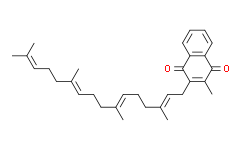 ( 母液浓度为 40 mg/mL ), 如您需要配置的浓度超过该产品的溶解度,请先与我们客服联系。
( 母液浓度为 40 mg/mL ), 如您需要配置的浓度超过该产品的溶解度,请先与我们客服联系。基本信息
|
产品编号: |
V10005 |
||||
|
产品名称: |
Vitamin K2 |
||||
|
CAS: |
863-61-6 |
储存条件 |
粉末 |
-20℃ |
四年 |
|
|
|
||||
|
分子式: |
溶于液体 |
-80℃ |
两年 |
||
|
分子量 |
444.65 |
-20℃ |
一个月 |
||
|
化学名: |
2-methyl-3-[(2E,6E,10E)-3,7,11,15-tetramethylhexadeca-2,6,10,14-tetraenyl]naphthalene-1,4-dione |
||||
|
Solubility (25°C): |
|||||
|
体外:
|
DMSO |
88mg/mL (197.9mM) |
|||
|
Ethanol |
|
||||
|
Water |
|
||||
|
体内(现配现用): |
1.请依序添加每种溶剂:10% DMSO→40% PEG300→5% Tween-80→45% saline Solubility: ≥ 2.08mg/mL (4.68mM); Clear solution |
||||
|
此⽅案可获得 ≥ 2.08mg/mL (4.68mM,饱和度未知) 的澄清溶液。 以 1mL ⼯作液为例,取 100μL 20.8mg/mL 的澄清 DMSO 储备液加到 400μL PEG300 中,混合均匀;向上述体系中加⼊ 50μL Tween-80,混合均匀;然后继续加⼊ 450μL ⽣理盐⽔定容⾄ 1mL。 |
|||||
|
2.请依序添加每种溶剂:10% DMSO→90% (20% SBE-β-CD in saline) Solubility: 2mg/mL (4.50mM); Suspended solution; Need ultrasonic |
|||||
|
此⽅案可获得 2mg/mL (4.50mM) 的均匀悬浊液,悬浊液可⽤于⼝服和腹腔注射。 以 1mL ⼯作液为例,取 100μL 20.0mg/mL 的澄清 DMSO 储备液加到 900μL 20% 的 SBE-β-CD ⽣理盐⽔⽔溶液中,混合均匀。 |
|||||
|
3.请依序添加每种溶剂:10% DMSO→90% corn oil Solubility: ≥ 2mg/mL (4.50mM); Clear solution |
|||||
|
此⽅案可获得 ≥ 2mg/mL (4.50mM,饱和度未知) 的澄清溶液,此⽅案不适⽤于实验周期在半个⽉以上的实验。 以 1mL ⼯作液为例,取 100μL 20.0mg/mL 的澄清 DMSO 储备液加到 900μL ⽟⽶油中,混合均匀。 |
|||||
|
<1mg/ml表示微溶或不溶。 |
|||||
|
普西唐提供的所有化合物浓度为内部测试所得,实际溶液度可能与公布值有所偏差,属于正常的批间细微差异现象。 |
|||||
|
请根据产品在不同溶剂中的溶解度选择合适的溶剂配制储备液;⼀旦配成溶液,请分装保存,避免反复冻融造成的产品失效。 |
|||||
制备储备液
|
浓度
溶液体积 质量 |
1mg |
5mg |
10mg |
|
1mM |
2.2490mL |
11.2448mL |
22.4896mL |
|
5mM |
0.4498mL |
2.2490mL |
4.4979mL |
|
10mM |
0.2249mL |
1.1245mL |
2.2490mL |
|
50mM |
0.0450mL |
0.2249mL |
0.4498mL |
生物活性
|
产品描述 |
Vitamin K2 (Menaquinone)是一种十分重要的脂溶性维生素,在保护心脏和大脑、构建强壮的骨骼过程中发挥重要作用。 |
|
|
靶点 |
Human Endogenous Metabolite |
Human Endogenous Metabolite |
|
体外研究 |
Menaquinone-4 (MK-4, 0, 1, 5, 10μM) increases the ALP activity in Caco-2 cells. Menaquinone-4 (1μM) significantly increases intensities of hSI expression |
|
|
体内研究 |
Menaquinone-4 (K2, 0.2 g/kg diet) in HF-K2 group produces epididymal fat in C57BL/6J mice, and also increases the bone density of mice |
|
推荐实验方法(仅供参考)
|
Cell Assay |
Caco-2 cells are plated at a density of 2-5 × 104 cells/cm2 onto a 35-mm dish. Cells are incubated for 2 to 3 days until 60%- 70% confluency, and desired concentrations of Menaquinone-4 (0, 1.0, 5.0, and 10.0μM) are added. The final concentration of the vehicle is 0.1% of the culture medium, and the culture medium is changed twice a week. Cells are assayed on days 0, 3, 7, and 11 after the addition of Menaquinone-4 |
|
|
|
|
Animal Administration |
Forty-two male, 4-week-old C57BL/6J mice provided with feed and drink ad libitum. For environmental adaptation, the animals had 1 week of circulation, and then are provided with the experimental diet after being randomly divided into 6 groups (7 animals in each group; randomized block design). The AIN-93G diets consist of a normal diet (N), normal diet + vitamin K1 (N-K1), normal diet + vitamin Menaquinone-4 (N-K2), 45% high-fat diet (HF), 45% high-fat diet + vitamin K1 (HFK1), and a 45% high-fat diet + vitamin Menaquinone-4 (HF-K2). The vitamin K1 and vitamin Menaquinone-4 contents are 200mg/1,000 g, and the diet is provided in pellet form. Body weight is measured once a week, and the food efficiency ratio (FER) is calculated by dividing the increased body weight from day 1 to the final day by the food intake amount during the experiment period. For fat amount measurement, the epididymal fat, perirenal fat, and retroperitoneal fat are extracted from dead animal subjects, are washed with 0.9% NaCl, dried by filter paper, and then are weighed |
本计算器可帮助您计算出特定溶液中溶质的质量、溶液浓度和体积之间的关系,公式为:
质量 (g) = 浓度 (mol/L) x 体积 (L) x 分子量 (g/mol)
摩尔浓度计算公式
用本工具协助配置特定浓度的溶液,使用的计算公式为:
开始浓度 x 开始体积 = 最终浓度 x 最终体积
稀释公式
稀释公式一般简略地表示为:C1V1 = C2V2 ( 输入 输出 )
(2).jpg)
 母液,添加 300 μLPEG300
母液,添加 300 μLPEG300 混匀澄清,再加 50μLTween80, 混匀澄清,再加 600μLSaline/PBS/ddH2O
混匀澄清,再加 50μLTween80, 混匀澄清,再加 600μLSaline/PBS/ddH2O 混匀澄清
混匀澄清方案所需的各种助溶剂如: DMSO , PEG300 / PEG400 , Tween 80 , SBE-β-CD , 玉米油 等, 均可点击跳转或在网站搜索购买。
计算结果:
工作液浓度: mg/ml;
DMSO母液配制方法: mg 药物溶于 μL DMSO溶液(母液浓度 mg/mL,
体内配方配制方法:取 μL DMSO母液,加入 μL PEG300,混匀澄清后加入μL Tween 80,混匀澄清后加入 μL Saline/PBS/ddH2O,混匀澄清。
1. 首先保证母液是澄清的;
2.
一定要按照顺序依次将溶剂加入,进行下一步操作之前必须保证上一步操作得到的是澄清的溶液,可采用涡旋、超声或水浴加热等物理方法助溶。




.png)





